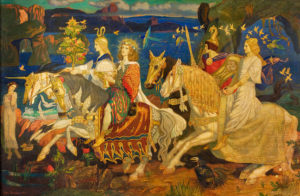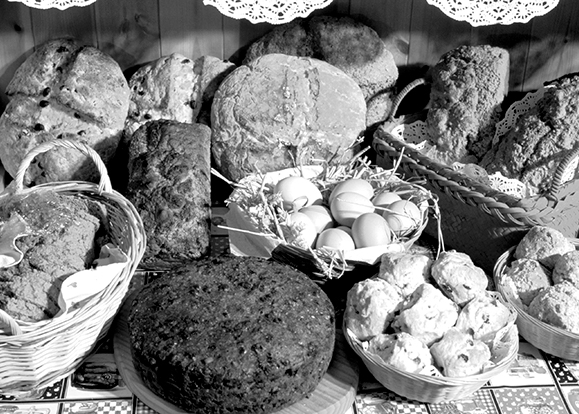The most joyous event of the Celtic year is Lughnasa (August 1), the beginning of the annual harvest. The Celtic calendar was structured on nature’s agricultural cycle and great festivals were celebrated at the start of each season: Imbolc (spring), Beltaine (summer), Lughnasa (autumn), and Samhain (winter). All honor the life-giving sun, but only Lughnasa derives its name from a legendary hero: Lugh Samhioldanach (The Multi-Talented).

Long before the arrival of the Gaels, Ireland was home to the magical Tuatha De Danann. Dwelling primarily around the Boyne Valley (where Newgrange and other historic sites are found today), the Tuatha De were tall, red-haired, fair-skinned, creative, intelligent, and aristocratic. They were the epitome of good, and the evil Fomor was their enemy.
It had been predicted that the Fomor king, Balor of The Evil Eye, could only be killed by his grandson. When his daughter fell in love with a prince of the Tuatha De and gave birth to Lugh, Balor ordered the child’s death. But Lugh was hidden and raised by fairies in the underwater Land of Eternal Youth, Tir na nÓg.
Many years later, as the Tuatha De Danann prepared for war with the Fomor, Lugh appeared with a fairy host at the royal fortress of Tara, demanding entrance on the grounds that he had mastered every known skill. The Tuatha chieftain, Nuada of the Silver Arm, welcomed this wondrous warrior, and together they set out to battle the Fomor. When Balor turned his Evil Eye on Nuada and slew him, Lugh fulfilled the prophecy by hurling a bolt of lightning through Balor’s Evil Eye, destroying him and all the Fomor army.
The story is older than time and as familiar as Star Wars. Wielding a light saber, Luke Skywalker triumphs over the Dark Force and his evil father Darth Vader. According to ancient Celtic beliefs, everything results from the interplay of opposing forces – light and dark, good and evil, birth and death, planting and harvest. When the crops are mature, they are cut down. Agriculture dies so that the people may survive.
And Lugh, who personifies the conflict inherent in opposing forces, has symbolized harvest throughout Celtic history.
When Christianity arrived in Ireland, grain from the year’s first threshing was ground up and baked into special loaves of bread that were taken to church and blessed at a “hlafmaesse” (loaf-mass). Lammas Fairs became very popular and the Ould Lammas Fair, held on the last Tuesday of August at Ballycastle, is thought to date from the fourteenth century when the McDonnells of Antrim distributed food to the needy.
In the many centuries, before early-producing crops were developed, July was known as the “Hungry Month.” Food stores put away from the previous year were dwindling and rations were meager. But as summer drew to its close the bounty of field and furrow was finally ready. Stone-ground grain was baked into loaves of aromatic soda bread. Tiny new potatoes were boiled in their jackets to be served whole with melted butter or mashed with boiled cabbage, leeks, scallions or garlic.
By lakes, streams, and holy wells, people gathered to feast and make merry. Young and old traipsed into the hills hunting fraughans, the flavorful wild Irish blueberry. Mixed into whipped fresh cream and served with delicate shortbread, they capped the meal. By the light of bonfires saluting the glorious sun and Lugh, champion of good, the dancing, and singing I went late into the night. Irish hospitality is legendary, but it is not a myth. The protocol of food and drink was set down in the Brehon Laws, which date from the fifth century A.D. Persons in high positions were required to entertain guests without asking any questions. Even in poor homes, an extra place was set at dinner in case there might be an unexpected visitor. It is no different today. Guests are always welcome at the Irish table…especially on Lughnasa. Slainte!
RECIPES
Fraughan (Blueberry) Fool
1-pint whipping cream
1-pint blueberries (frozen work perfectly)
sugar to taste
In a large bowl, whip cream and set aside. In another bowl, crush berries and stir in sugar. Fold crushed berries in whipped cream. Chill. Makes 4 servings.
Shortbread
4 ounces butter (room temperature)
1/4 cup superfine sugar
1 1/2 cups flour
Preheat the oven to 350 F. Beat butter with sugar until light and fluffy. Add flour 1/2 cup at a time and mix thoroughly. Gather into a ball. On a lightly floured surface, roll dough 1/4-inch thick and cut into 2-inch rounds. Place on a lightly greased cookie sheet. Repeat the process until all dough scraps are used. Bake for 15 minutes or till the cookies are a light golden brown. Cool on a wire rack. Makes 1 dozen.
Recipes courtesy of Darina Allen, Ballymore Cookery School, Shanagarry, Co. Cork, Island. ♦


Thanks you so very much for recipes! Blueberries are so delicious here in Michigan, so a “fool” will happen! Thanks, also, for this wonderful issue and all the many subjects you cover! I love the literary includsions.
????????????????????
An excellent article. The Tuatha De Danann are also alleged to have taken part in a major battle at Moytura,
near Cong, County Mayo, where they defeated the Fir Bolgs (Fat Men). They are also believed to be involved
in activities at Cnoch Meadh, a big hill a few miles from Tuam, County Galway, on the road to Caherlistrane
and Headford.